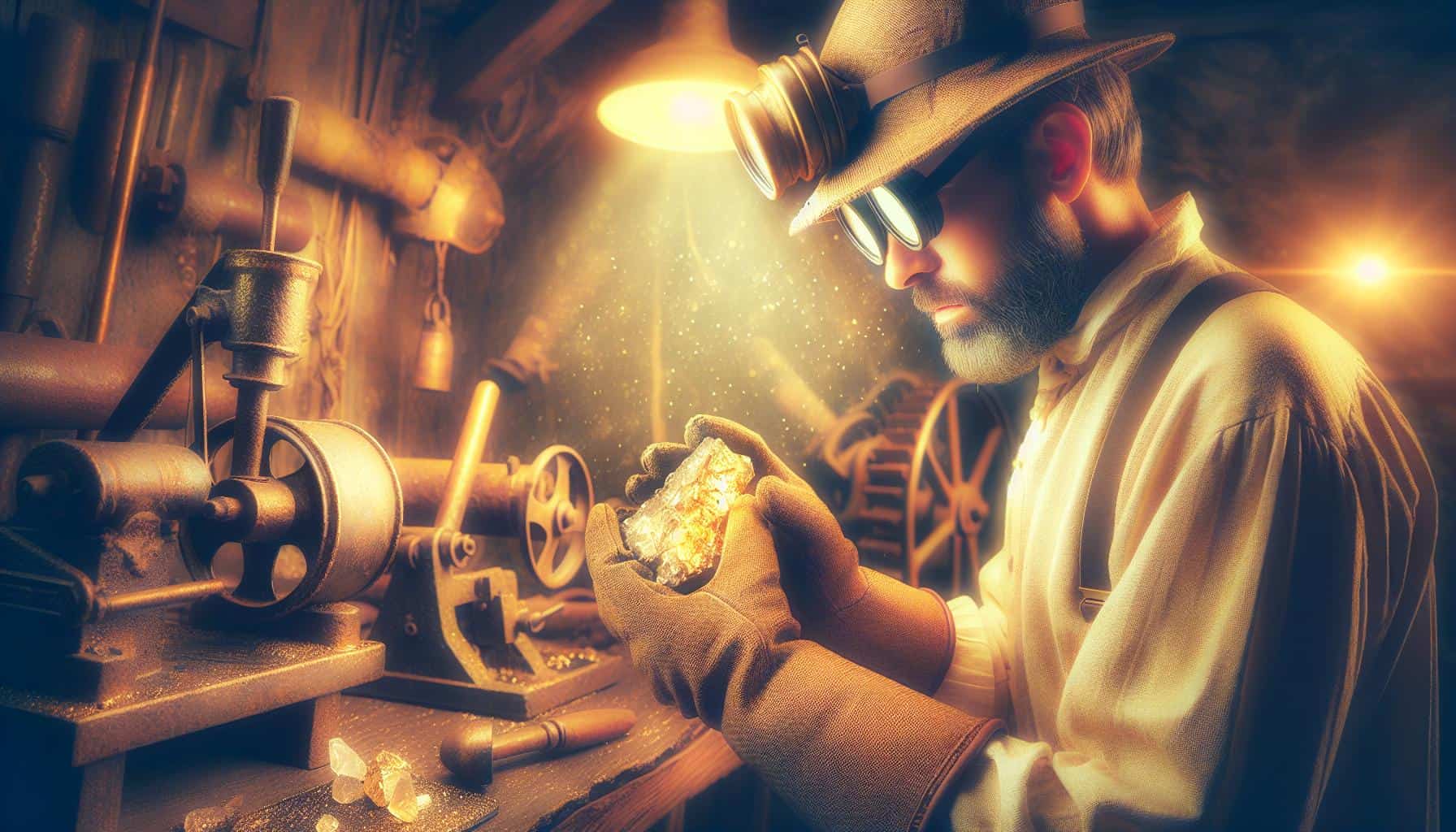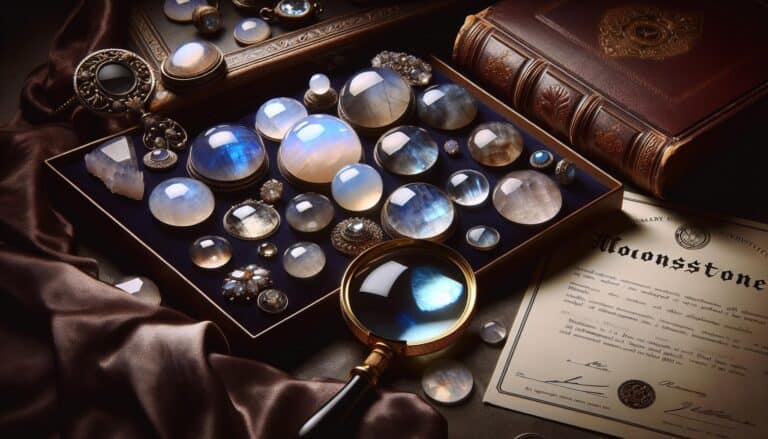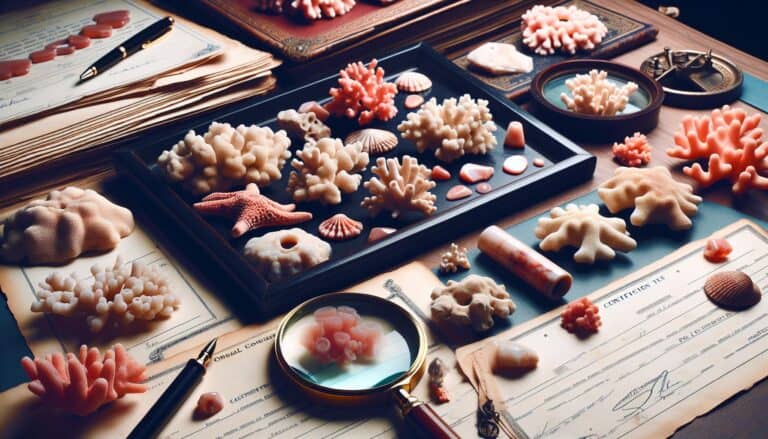Ever wondered how to extract that precious gold from the quartz you’ve stumbled upon?
You’re not alone. Gold prospecting is an age-old quest that can still pay off big time if you know what you’re doing.
Extracting gold from quartz requires patience and a bit of know-how. Don’t worry, though; you’re about to learn the techniques that’ll help you separate the gold from its rocky encasement.
Whether you’re a seasoned prospector or a curious newbie, this guide is your golden ticket to unlocking the secrets of gold extraction from quartz.
Extracting gold from quartz involves crushing the rock, pulverizing it, and using methods like panning to separate gold. Essential tools include a hammer, chisel, and safety gear. Success requires careful adherence to each step and safety precautions, turning effort into valuable gold.
The Basics of Gold Extraction from Quartz
Before you dive into the nitty-gritty of gold extraction, it’s crucial to understand the basics of gold-bearing quartz veins. These veins are often found in areas where the earth’s crust has been subjected to extreme pressures and temperatures, leading to the formation of crystalline rocks with gold deposits.
To successfully extract gold from quartz, you’ll need to identify the rich gold-bearing areas. Look for signs like black streaks or visible pieces of gold within the quartz. Once you’ve located a promising spot, it’s time to gather your tools. Essential equipment includes:
- A sturdy hammer
- A chisel or pick
- Protective eyewear
- Gloves
Your main goal is to break the quartz to liberate the gold. Striking the quartz carefully with your hammer and chisel is the traditional method. Focus on areas where the gold is visible or the quartz has a dark, mineralized streak. It’s also important to pulverize the quartz to fine sand to effectively free all the gold.
Technology plays an immense role in modern-day mining. Advanced enthusiasts might use mechanical crushers or ball mills to grind the quartz down before utilizing chemicals like cyanide or mercury, although these substances must be handled with extreme caution due to their toxicity and environmental impact.
Panning remains a time-tested technique. After crushing, you can pan the powdered quartz in water. Gold, being heavier, settles at the bottom and can be separated with careful swirling movements.
Remember, safety first; when dealing with tools and potentially hazardous chemicals, make sure to wear appropriate protective gear and follow safe handling practices.
Seeking gold within quartz is a mix of skill, patience, and knowledge. Equipping yourself with the right techniques and tools can make the task at hand not just profitable but also enjoyable. Keep in mind that practice makes perfect. With each trial, you’re learning and improving your prospecting skills.
Composition of Quartz and Gold
Before you can extract gold from quartz, it’s essential to grasp what you’re dealing with at a molecular level. Quartz, scientifically known as silicon dioxide or SiO2, is one of the most common minerals on Earth’s surface. It forms a crystal lattice that’s robust and resistant to weathering, which is why it often entraps valuable minerals like gold.
Gold, on the other hand, is a soft, malleable metal with an atomic number of 79. Its unique properties, such as its ability to resist corrosion and its excellent conductivity, make it highly sought after. When gold is found in quartz, it’s typically in its elemental form, sometimes visible to the naked eye as small flecks or larger nuggets within the veins of the quartz.
The distribution of gold within quartz can vary substantially:
- Large, visible chunks, known as nuggets
- Fine, powder-like particles, called dust
- Microscopic inclusions, which are often referred to as invisible gold
These varieties dictate the method you’ll need to employ for extraction. For instance, large chunks can sometimes be removed from the quartz matrix using simple hand tools, while finer materials may require chemical treatments to free the gold from its host.
Recognizing high-grade gold quartz is an art and a science. You’ll be looking for certain signs that are indicative of rich deposits:
- Discoloration: Iron staining on quartz could suggest the presence of gold.
- Vein patterns: The structure and texture of the quartz might give clues about the gold content.
- Specific gravity: Gold-rich quartz feels heavier than typical quartz rocks due to the density of the gold vein.
Tools like a magnifying glass or a hand lens can be invaluable for close inspection of the rock, allowing you to discern between worthless material and quartz that’s worth processing. Additionally, portable field tests such as acid scratch tests can give you a preliminary idea about gold presence before committing to extensive extraction processes.
Tools and Equipment Needed for Gold Extraction
As you delve into the task of extracting gold from quartz, having the right tools and equipment is essential. Prospecting does not just rely on spotting the right rocks; it’s about effectively separating the gold. There are several tools you’ll need to achieve this.
Firstly, a rock hammer and a chisel are basic yet indispensable tools. They allow you to chip away at quartz and extract the specimens of interest. For those larger chunks of quartz, a sledgehammer may be necessary to break them down to more manageable sizes.
Safety cannot be overstressed, so make sure you’re wearing protective eyewear and gloves. The process can send small chips of rock and dust flying, which could cause injury without the proper protection.
For the finer extraction process, you’ll want to have a gold pan. This simple device helps in washing away lighter materials while allowing gold, which is denser, to settle at the bottom. If you’re dealing with gold that’s not visible to the naked eye, chemicals like hydrofluoric acid can be used to dissolve quartz, but it’s critical to handle these with extreme care due to their hazardous nature.
A portable field kit containing a magnifying glass and test tubes for specific gravity tests can aid in discovering potential gold-laden quartz on-site. For those looking to process larger quantities of ore, a crusher can be employed to pulverize the quartz, making the gold easier to extract.
When dealing with fine particles of gold within quartz, many prospectors turn to a sluice box or a shaker table. These pieces of equipment help to separate fine gold from other minerals based on density.
Always remember that investing in quality equipment is investing in your prospecting success. High-quality tools not only increase efficiency but also improve the likelihood of extracting every bit of gold from your quartz finds. Keep in mind that patience and precision are key, as the rush to extract can lead to overlooking small but significant specks of gold.
Step 1: Crushing the Quartz
Before diving headfirst into crushing the quartz, recognize that it’s the pivotal first step to liberate the gold within. Quartz is an incredibly hard mineral, second only to diamond on the hardness scale, so you’ll need sturdy tools and a solid plan.
Start by donning your safety gear. Eye protection, gloves, and a dust mask are non-negotiables to safeguard against flying debris and silica dust. You’ll thank yourself later for this extra caution.
Let’s get to the nitty-gritty. Using your rock hammer and chisel, carve out chunks of the quartz vein from its host environment. Be sure to pick through these pieces to determine which have the potential for gold. Not all quartz holds the precious metal, so it’s crucial to be selective.
- Place the quartz chunks on a flat, solid surface that can withstand heavy impact.
- Position the chisel point at the top of the rock, and strike it firmly with your hammer. The aim? To break the quartz into smaller, more manageable pieces.
For larger batches, you might want to consider using a crusher. A crusher is a machine designed to reduce large rocks into smaller rocks, gravel, or rock dust, and can significantly expedite the process.
| Method | Reduction Size | Tool Required |
|---|---|---|
| Manual Crushing | Small to medium pieces | Hammer, Chisel |
| Machine Crushing | Very small pieces, dust | Crusher |
After crushing the rocks to a fine consistency, ensure you’ve got all the smaller pieces gathered; they are now ready for the extraction of gold. It’s worth noting that the degree to which you’ll crush the quartz depends largely on the equipment at your disposal and the size of the gold particles you’re targeting. Smaller gold particles will require a finer crush to be liberated from the quartz, while larger pieces can be more easily separated with a less fine crush.
Keep in mind: patience pays. This initial step sets the foundation for your success in extracting gold from quartz. With your crushed material, you’re one step closer to the prize—a testament to your hard work and diligence.
Step 2: Pulverizing the Quartz
Once you’ve selected the quartz pieces with the potential for gold and have safely crushed them into smaller chunks, pulverizing the quartz is your next step. This process is crucial, as it allows you to break down the quartz into a fine powder, making the extraction of gold much easier.
Pulverizing quartz can be achieved through several methods, with the most common being the use of a ball mill. A ball mill works by rotating a cylinder with steel grinding balls, causing the balls to fall back into the cylinder and onto the quartz, pulverizing it into a fine dust. This method is preferred due to its efficiency and the fine consistency of powder it produces.
Here’s a quick guide on using a ball mill:
- Ensure you’re wearing the proper safety gear, including safety glasses and dust masks.
- Load the crushed quartz into the ball mill along with the grinding balls.
- Ensure the mill is set to the correct speed and let it run for a sufficient period, typically several hours.
- Check periodically to see if the quartz has reached a fine powder consistency.
If you don’t have access to a ball mill, a hand-operated mortar and pestle can be used. The process is more labor-intensive but can be just as effective:
- Place smaller portions of the crushed quartz into the mortar.
- Thoroughly grind the pieces with the pestle until a fine powder is formed.
- Repeat the process until all your quartz chunks have been turned into dust.
| Method | Description | Notes |
|---|---|---|
| Ball Mill | Efficient mechanical pulverization | Requires specific equipment |
| Mortar and Pestle | Traditional, manual grinding | Labor-intensive, accessible equipment |
After pulverizing the quartz into a fine dust, panning or other gold-separation techniques will become much more effective. This is because the fine powder allows heavier gold particles to separate more readily from the lighter quartz materials.
Step 3: Removing the Quartz Veins
Once you’ve selected your quartz and crushed it into smaller chunks, the next crucial phase is to remove the quartz veins that potentially hold gold. This process requires meticulous attention, as the goal is to retain as much of the gold-bearing quartz as possible.
Start by sorting the crushed quartz. Use a magnifier to closely examine the pieces and separate the gold-rich veins from the less promising ones. You’re looking for visible specks of gold or areas where the quartz is noticeably denser. These are prime indicators of gold presence.
Safety should be your top priority. When handling sharp quartz shards, always wear thick gloves and eye protection. Inhaling quartz dust is hazardous to your lungs, so a dust mask or respirator should be part of your gear along with safety glasses or goggles.
To extract the veins, you might need tools like tweezers or a small pick. Work gently to avoid breaking off pieces of gold. The idea is to carefully chip away the surrounding quartz until you isolate the vein. Depending on the size and strength of the vein, this may take some time and patience.
For larger veins, use a hammer and chisel. Position your chisel near the edge of the vein and gently tap with the hammer to dislodge it. If the vein doesn’t detach easily, avoid forcing it; fractures can result in the loss of gold. Instead, reassess your approach and try from a different angle. Remember, haste can lead to wasted effort and lost gold.
Those well-versed in this method develop a keen eye for identifying the most promising veins and an understanding of how much force is appropriate for chisel work. Here are a few pointers:
- Aim the chisel toward the center of the vein, away from the edges, to prevent shattering.
- Practice on less-promising pieces to perfect your technique.
- Keep your work area well-lit, so you don’t miss any tell-tale signs of gold.
This meticulous vein removal is what sets successful prospectors apart. The time invested here can significantly impact the quality and quantity of gold you extract.
Step 4: Separating the Gold from the Crushed Quartz
Once you’ve successfully crushed and pulverized the quartz, the next pivotal step is gold separation. This phase requires precision and attention to detail to ensure that the precious metal isn’t lost in the process.
The first technique you’ll want to consider is gravity separation. Essentially, gold, being much heavier than most of the other substances it’s mixed with, will settle at the bottom when swirled with water. Hence, you’ll start with panning. You’ll need a shallow pan; fill it with water and add your crushed quartz. Swirl the pan with a vigorous motion. The heavy gold particles will migrate to the pan’s bottom, allowing you to separate them from the lighter quartz particles.
For finer gold particles, sluicing is an excellent option. A sluice box, lined with riffles, traps the heavier gold as the crushed quartz and water mixture flows through. Here’s a quick rundown of sluicing:
- Set up the sluice box at a slight downhill angle.
- Pour the water and quartz mixture at the top of the sluice.
- Allow gravity to carry the mixture down over the riffles.
- Collect the material that gets trapped; this is where your gold will be.
If you’re dealing with gold that’s embedded in the quartz and too small to be panned out, you might require chemical separation. Gold can be separated from quartz via solutions like cyanide or mercury, amalgamation, but bear in mind these chemicals are toxic and their use is heavily regulated. You should only pursue chemical methods if you have the proper equipment, safety gear, and expertise.
Magnetic separation is also possible due to the distinct magnetic susceptibility of gold compared to other minerals in the quartz. Using a high-powered magnet can help you remove the iron-based minerals, and what remains is more likely to contain gold.
Remember to conduct all separation processes with great care to minimize the loss of gold and always adhere to safety protocols to prevent accidental exposure to hazardous materials. After separation, the extracted gold will often need further refinement to achieve a more pure state. This can involve procedures like acid baths or even smelting, depending on the gold’s purity level following initial separation.
Step 5: Cleaning and Smelting the Gold
Once you’ve effectively separated the gold from the crushed quartz, the next critical phase is to clean and smelt the extracted material to purify it further. Cleaning the gold is significant as you’ll want to remove any remaining impurities before smelting it. This process is typically accomplished using a combination of physical and chemical methods.
To start, you’ll use a strong jet of water to wash away the lighter materials. This simple yet effective technique is known as hydraulic washing. It’s particularly useful if you’ve collected fine particles from panning or sluicing. For the best results:
- Place your gold in a metal pan or container.
- Direct a high-pressure stream of water over the gold.
- Agitate the contents gently to ensure thorough separation of lighter materials.
Afterward, it’s time for acid treatment, commonly using nitric acid, to dissolve any leftover impurities like silver or base metals that aren’t gold. Handle all chemicals with extreme care and make sure you’re wearing the proper safety equipment.
Onto smelting—your chief objective here is to melt down the gold and pour it into a mold, creating a solid and pure gold bar or button. Smelting requires a furnace, where temperatures must be raised above the melting point of gold, which is approximately 1,947 degrees Fahrenheit (1,064 degrees Celsius). While performing this step, ensure the workspace is well-ventilated and that you’re adhering to all necessary safety measures to prevent accidents.
| Melting Point | Temperature (°F) | Temperature (°C) |
|---|---|---|
| Gold | 1,947 | 1,064 |
During the smelting process, it’s vital to use a flux, such as borax or soda ash, which helps reduce the melting point of the impurities and brings them to the surface. Once the gold is liquefied, these impurities rise to the top and can be skimmed off easily.
Finally, pour the molten gold into a mold of your choice. The gold will cool and solidify, forming a nugget or bar that boasts a considerably higher purity level than what you started with. Remember, the specific details of smelting can vary based on the equipment you have access to and the quantity of gold you’re processing.
Tips and Precautions for Successful Gold Extraction
When setting out to extract gold from quartz, it’s paramount to adhere to certain tips and precautions to ensure not only successful results but also your safety. Firstly, wear protective gear. Unexpected chips of quartz or errant dust particles can pose a risk to your eyes and lungs, so donning safety goggles, a dust mask, and gloves is a must.
Be mindful of the quartz quality you choose to work with. Selecting the right quartz is akin to setting a strong foundation for your gold extraction process. Look for visible gold veins within your quartz specimens, as these indicate a higher prospect of gold content.
In the crushing stage, take your time and go slowly. Rushing could result in overlooked gold, which might be discarded with the waste material. Remember that patience here could mean the difference between a sizable gold yield and a menial one. Moreover, check your equipment regularly for wear and tear. Regular maintenance ensures efficient processing and prevents any potential contaminant release into the environment.
Understand your local regulations concerning gold extraction. You’ll need to familiarize yourself with the legal considerations, including land rights, mining permits, and environmental protocols. It’s especially critical to adhere to these guidelines to avoid hefty fines or legal challenges.
During the separation phase, consider using multiple techniques to ensure maximum gold recovery. For instance, combining gravity separation with chemical treatment may yield more promising results than relying on a single method.
Remember that gold extraction can be a complex endeavor. Hence, if you’re new to gold prospecting or don’t feel confident about carrying out this process on your own, consulting with a professional or joining a miner’s association can be invaluable. They can provide expert guidance, updated techniques, and support which can significantly bolster your chances of success.
Approach each step with thorough research and consideration, to maximize your returns while preserving the environment and staying within legal boundaries. Your diligence and adherence to these tips and precautions will not only enhance the efficiency of the extraction but also pave the way for a more rewarding gold prospecting experience.
Conclusion on Getting Gold from Quartz
Unlocking the treasure within quartz requires your dedication and attention to detail.
Remember to suit up in protective gear and choose quartz with gold that catches your eye. Your patience will be tested as you meticulously crush and separate the gold but it’s vital for your success. Keep your equipment in top shape and stay informed about the mining laws that apply to you. Don’t hesitate to reach out to experts and fellow enthusiasts for advice. With these strategies in hand, you’re well on your way to reaping the rewards of your gold prospecting journey.
Stay persistent and the sparkle of success will be yours.







